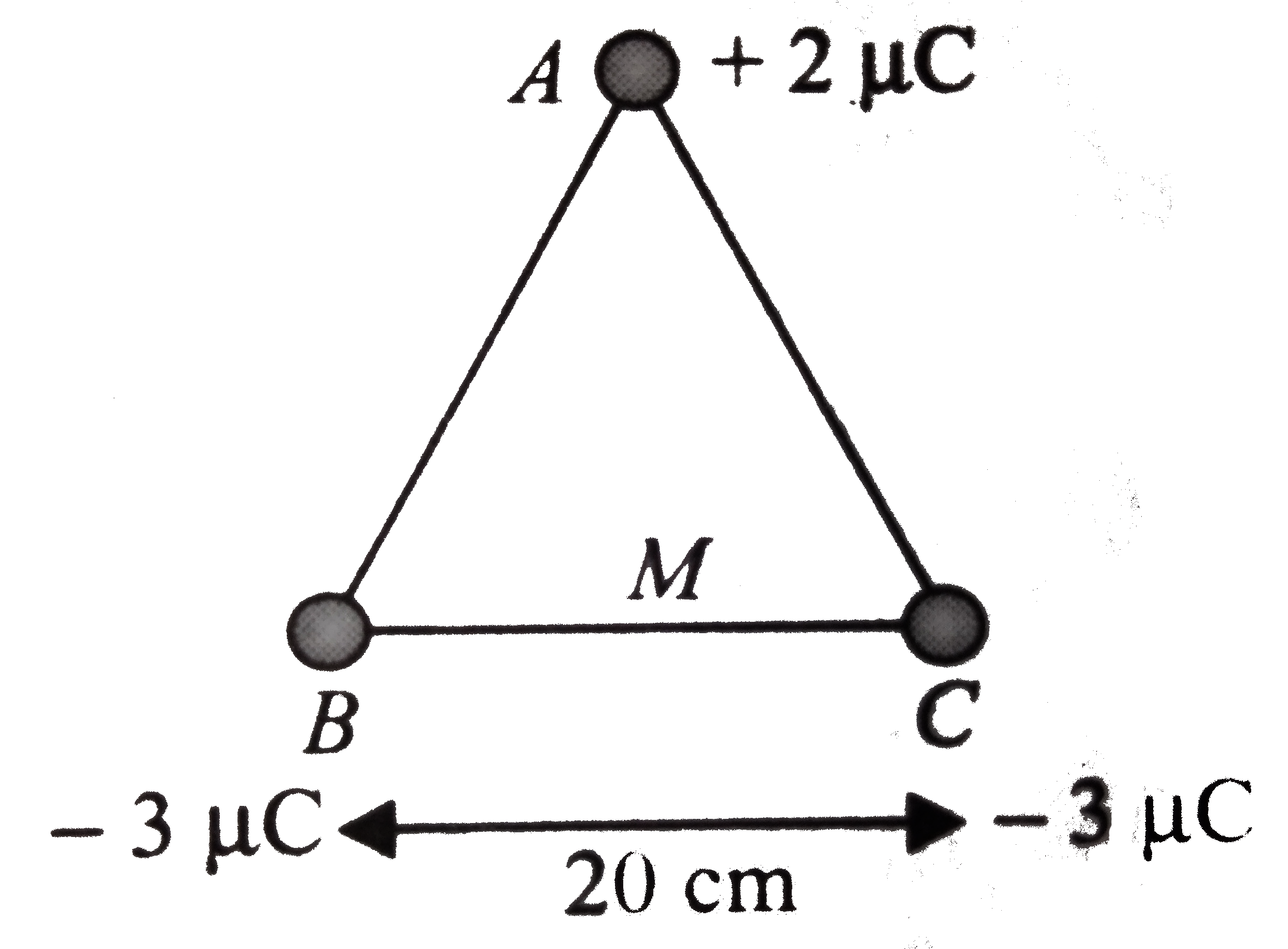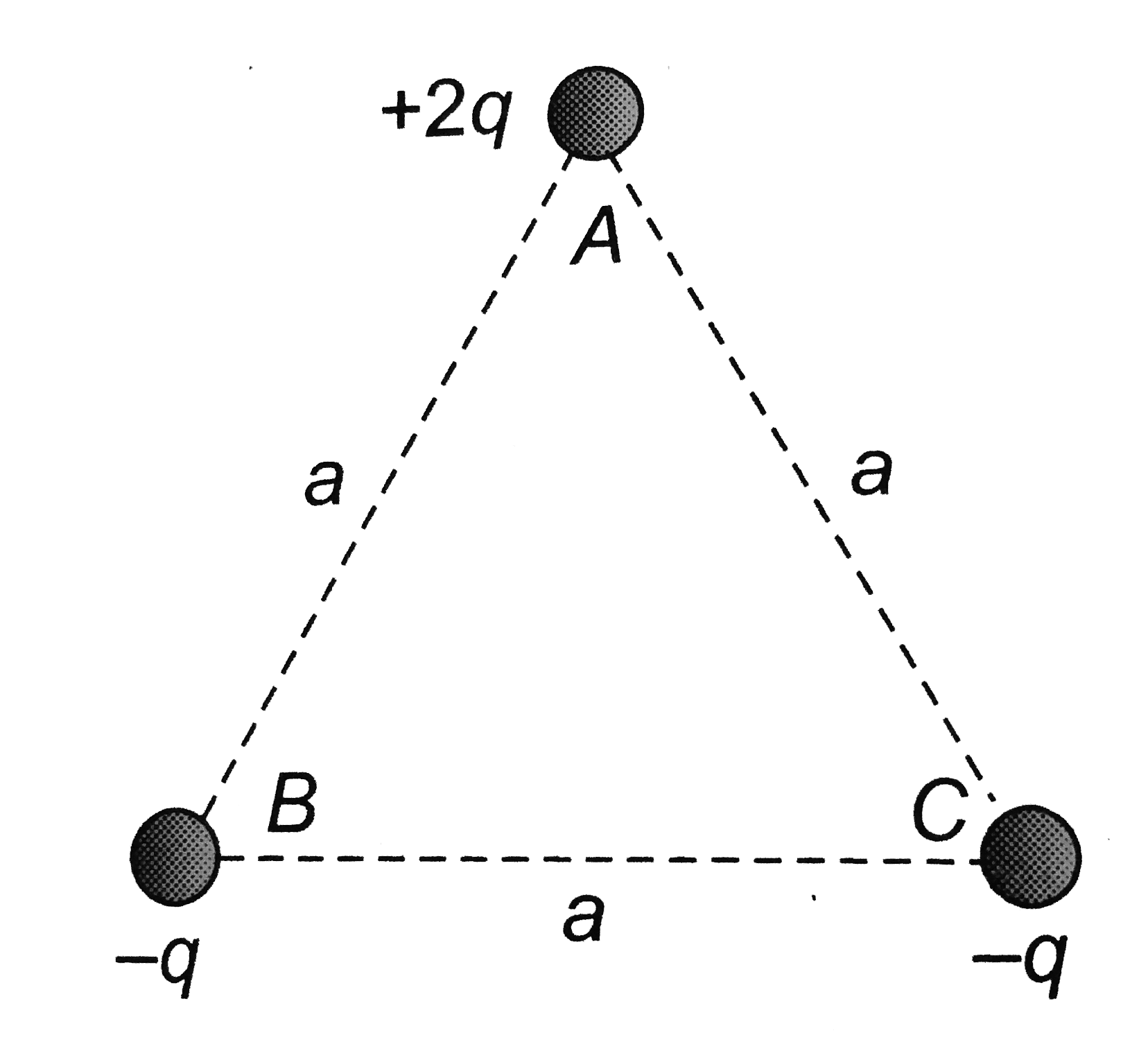Electric charge of 1μC,−1μC and 2μC are placed in air at the corners A, B and C respectively of an equilateral triangle ABC having length of each side 10 cm. The resultant force on the charge at C is
0.9 N
1. 8N
2.7 N
3.6 N
The correct Answer is:B
To find the resultant force on the charge at point C in the given configuration, we will follow these steps:
Step 1: Identify the Charges and Their Positions
We have three charges:
- Charge at A: QA=1μC=1×10−6C
- Charge at B: QB=−1μC=−1×10−6C
- Charge at C: QC=2μC=2×10−6C
These charges are placed at the corners of an equilateral triangle ABC with each side measuring 10cm=0.1m.
Step 2: Calculate the Forces on Charge C
The forces acting on charge C due to charges A and B need to be calculated.
Force due to Charge A on Charge C (FAC)
The force between two charges is given by Coulomb's Law:
F=k|Q1Q2|r2
Where:
- k (Coulomb's constant) =8.99×109Nm2/C2
- Q1=QA=1×10−6C
- Q2=QC=2×10−6C
- r=0.1m
Calculating FAC:
FAC=k|QAQC|r2=8.99×109(1×10−6)(2×10−6)(0.1)2
=8.99×1092×10−120.01=8.99×109×2×10−10=1.798N
The direction of FAC is away from charge A (repulsive force).
Force due to Charge B on Charge C (FBC)
Calculating FBC:
FBC=k|QBQC|r2=8.99×109|−1×10−6⋅2×10−6|(0.1)2
=8.99×1092×10−120.01=8.99×109×2×10−10=1.798N
The direction of FBC is towards charge B (attractive force).
Step 3: Determine the Angle Between the Forces
Since the triangle is equilateral, the angle between the forces FAC and FBC is 120∘.
Step 4: Calculate the Resultant Force
Using the formula for the resultant of two forces:
FR=√F2AC+F2BC+2FACFBCcos(120∘)
Substituting the values:
FR=√(1.798)2+(1.798)2+2⋅(1.798)⋅(1.798)⋅(−0.5)
=√2⋅(1.798)2−(1.798)2=√(1.798)2
=1.798N
Final Result
The resultant force on the charge at C is approximately:
FR≈1.798N
We have three charges:
- Charge at A: QA=1μC=1×10−6C
- Charge at B: QB=−1μC=−1×10−6C
- Charge at C: QC=2μC=2×10−6C
The forces acting on charge C due to charges A and B need to be calculated.
The force between two charges is given by Coulomb's Law:
F=k|Q1Q2|r2
Where:
- k (Coulomb's constant) =8.99×109Nm2/C2
- Q1=QA=1×10−6C
- Q2=QC=2×10−6C
- r=0.1m
FAC=k|QAQC|r2=8.99×109(1×10−6)(2×10−6)(0.1)2
=8.99×1092×10−120.01=8.99×109×2×10−10=1.798N
Calculating FBC:
FBC=k|QBQC|r2=8.99×109|−1×10−6⋅2×10−6|(0.1)2
=8.99×1092×10−120.01=8.99×109×2×10−10=1.798N
Since the triangle is equilateral, the angle between the forces FAC and FBC is 120∘.
Using the formula for the resultant of two forces:
FR=√F2AC+F2BC+2FACFBCcos(120∘)
Substituting the values:
FR=√(1.798)2+(1.798)2+2⋅(1.798)⋅(1.798)⋅(−0.5)
=√2⋅(1.798)2−(1.798)2=√(1.798)2
=1.798N
The resultant force on the charge at C is approximately:
FR≈1.798N
Topper's Solved these Questions
- ELECTROSTATICSBOOK - DC PANDEY ENGLISHCHAPTER - ELECTROSTATICSEXERCISE - Check point 1.3
10 Videos
- ELECTROSTATICSBOOK - DC PANDEY ENGLISHCHAPTER - ELECTROSTATICSEXERCISE - Check point 1.4
10 Videos
- ELECTROSTATICSBOOK - DC PANDEY ENGLISHCHAPTER - ELECTROSTATICSEXERCISE - Check point 1.1
10 Videos
- ELECTROSTATIC POTENTIAL AND CAPACITORSBOOK - DC PANDEY ENGLISHCHAPTER - ELECTROSTATIC POTENTIAL AND CAPACITORSEXERCISE - (C) Chapter exercises
50 Videos
- GRAVITATIONBOOK - DC PANDEY ENGLISHCHAPTER - GRAVITATIONEXERCISE - All Questions
135 Videos
Similar Questions
Three point charges of +2μC,−3μC , and −3μC are kept at the vertices A, B, and C, respectively of an equilatreral triangle of side 20 cm. what should be the sign and magnitude of the charge (q) to be placed at the midpoint (M) of side BC so that the charge at A remains in equilibrium?

View SolutionThree point charges Q1=25μC,Q2=50μC and Q3=100μC, are kept at the corners A, B and C respectively of an equilateral triangle ABC having each side equal to 7.5 m. Calculate the total electrostatic potential energy of the system.
View Solution
Knowledge Check
Consider the charges q,q and -q placed at the vertices of an equilateral triangle of each side l. What is the force on each charge ?
Aq24√2πε0l2B−q24πε0l2Cq24πε0l2DzeroElectric charges q,q,–2q are placed at the corners of an equilateral triangle ABC of side l. The magnitude of electric dipole moment of the system is
AqlB√3qlCzeroD4ql
Electric charges of +10μC,+5μC,−3μCand+8μC are placed at the corners of a square of side √2 m, the potential at the centre of the square is
View SolutionThree point charges of +2q,+2qand−4q are placed at the corners A, B and C of an equilateral triangle ABC of side x. The magnitude of the electric dipole moment of this system is ?
View SolutionCharges 5.0×10−7C,−2.5×10−7Cand1.0×10−7C are
held fixed at the three corners A, B, C of equilateral triangle of side 10cm respectively. Find the electric force on the charge at C due to the rest two.
View SolutionCharges 5μC,−2μC,3μCand−9μC are placed at the corners A,B,C and D of a square ABCD of side 1m. The net electric potential at the centre of th square is
View SolutionElectric charges q,q,–2q are placed at the corners of an equilateral triangle ABC of side l. The magnitude of electric dipole moment of the system is
View SolutionThree charges of (+2q),(−q) and (−q) are placed at the corners A,B and C of an equilateral triangle of side a as shown in the adjoining figure. Then the dipole moment of this combination is

View Solution
